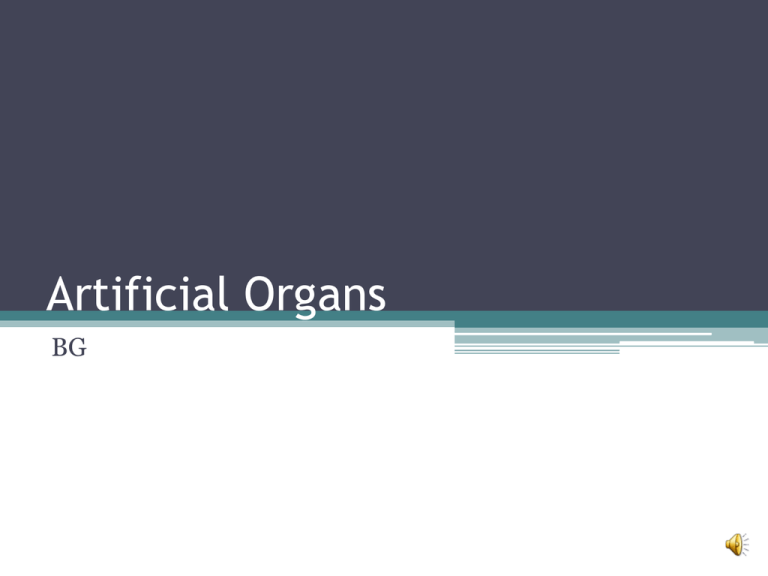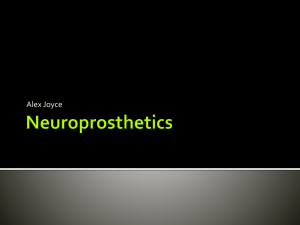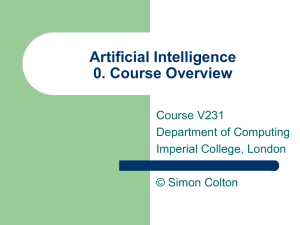Artificial Organs
advertisement

Artificial Organs BG Index • • • • • • • • What are artificial organs? Artificial skin Dialysis Artificial pancreas Artificial hearts Artificial kidney Artificial liver Artificial lung What are artificial organs? • Shortage of donor organs • Substitute for natural organs • When organs fail to perform, artificial replace them • Some devices provide assistance, some replace the organ • Manage patients with disease by providing transplantation What are artificial organs? • Either fully artificial or bio artificial • “bio hybrid organs” are a combo of biologic and synthetic components • They incorporate many technologies: Sensors Biomaterials Innovative delivery systems Artificial Skin • When skin is damaged due to severe injury or burn, bacteria has easy access to body fluids • When bacteria gets in body fluids causes “circulatory collapse” or shock when blood pressure in arteries is too low to maintain an adequate supply of blood to organs and tissues • Prevent this they use artificial skin Artificial Skin • There’s an artificial skin system called “Integra” Its an artificial substance that contains no living components Not designed to replace skin Rather supplies protective covering and pliable scaffold onto which a persons own skin cells can regenerate on the destroyed layer or skin. • 2 different types of skin grafts Autologous and allograft Artificial Skin • Autologous skin grafts transfer skin from one part of body to another • Allograft transfers skin from another person only offer temporary cover, rejected by immune system • Skin grafts produced by taking cells from non-burned layer of skin, growing them into large sheets of cells then placing cell sheets on top of Integra • To treat burn/injury : remove burned/damaged skin Quickly cover with underlying tissue (artificial skin + grown skin cells) Dialysis • Treatment that performs functions of kidneys • Needed when kidneys can no longer take care of body’s needs • Starts with loss of kidney function of 85%-90% • Keeps body in balance Removes wastes, salt and extra water to prevent building up Keeps safe level of certain chemicals in blood Helps control blood pressure • Done in hospital, dialysis unit or at home Dialysis • 2 types: Hemodialysis + peritoneal dialysis • Hemodialysis: Hemodialyzer is used to remove waste, extra chemicals and fluid from your blood Treatments last about four hours, done three times a week • Peritoneal Dialysis: Blood cleaned inside body Catheter is placed in abdomen Peritoneal cavity is slowly filled with dialysate Blood stays in arteries and veins Extra fluid and waste products are drawn out of blood Artificial Pancreas • Used for type 1 diabetes • Takes over managing patients disease • Monitors blood sugar and delivers insulin in doses that’s for patients needs • Designed to replicate aspects of human metabolism Complex progress that converts energy from food into energy body can use • Device incorporates measurements of physical activity and the person metabolic response • Size of small paper book Artificial Pancreas • There's an abdominal patch that continuously measures blood sugar • A pager sized pump that delivers insulin beneath the skin • Continuous glucose monitor(CGM) that channels real-time blood sugar readings to insulin pump This directs pump to dispense proper amount of insulin to keep blood sugar levels correct • Software algorithm, linking patch and pump Loaded with information derived from patient All automated Artificial Heart • Provide mechanical circulatory support • Used for severe heart failures Heart failure is a condition where heart can no longer provide enough blood to keep with the body’s needs. Caused by coronary artery disease, cardiomyopathy, heart attack, congenital heart problems • Two types of artificial hearts: VAD’s and TAH’s VAD Artificial Heart • • • • • Ventricular Assist Devices (VAD) Does not replace heart, works along side it Mechanical pump Surgically implanted next to heart Runs on power from a battery pack that you carry at your side, constantly helping your heart to pump blood • Attached to left ventricle and to aorta • Works by helping heart pump blood from left ventricle into aorta • Then the blood circulates through the body VAD Artificial Heart • After this surgery several meds are needed to be taken regularly, like blood thinners • This pump can be a bridge to transplant, keeping patient healthy while waiting for donor heart TAH Artificial Heart • Total Artificial Heart (TAH) • Device that replaces the two lower chambers of the heart (the ventricles) • Used for “end stage’ heart failure So severe all treatments have failed • TAH is attached to hearts upper chambers(Atria) • Between the TAH and Atria are mechanical valves that work like the hearts own valves • These control the flow of blood in the heart • Two types of TAH’s (known by brand name) CardioWest and AbioCor CardioWest TAH • Connected to outside power source • Has tubes that run from inside chest to outside power source • Tubes exit the body and connects to a machine that powers and controls the CardioWest TAH AbioCor TAH • Contained inside the chest • Battery powered • Battery is charged through skin with a special magnetic charger • Energy from the external charger reaches the internal battery through an energy transfer device transcutaneous energy transmission (TET) • Implanted TET device is connected to the implanted battery AbioCor TAH • An external TET coil is connected to the external charger • An implanted controller monitors and controls the pumping speed of the heart Artificial Kidney • One day could eliminate need for dialysis • Device includes thousands of microscopic filters • A bioreactor to mimic metabolic and water balancing roles of real kidney • Two stage system: 1. Nano scale filters and removes toxins from the blood 2. Bio cartridge of renal tubule cells mimics the metabolic and water balance roles • Uses hemofilter to remove toxins from blood Artificial Kidney • Engineering to grow renal tubule cells to provide other biological functions of a healthy kidney • Progress relies on body’s blood pressure to perform filtration without needing pumps or an electrical power supply • Ready in about 5-7 years Artificial Liver • Researchers made transplantable liver grafts for rats May point toward successful liver transplant substitute for humans • The livers job is to help fight infection, clean blood, digest food and store energy • To be successful, artificial liver must be large to provide enough liver function • This requires a network of small blood vessels (micro vascular network) to transport oxygen and nutrients throughout the structure Artificial Liver • Decellularization (process of removing cells from structure but leaving it with the architecture of original tissue) has shown some success in other organs • Scientists decellularized the liver while preserving it’s structure • A matrix of proteins remained behind to hold livers shape • Using a dye showed that microvascular network in each translucent liver was intact • Researchers were able to successfully introduce hepatocytes (liver cell) back into matrix Artificial Liver • Tested recellularized matrix, it carried out liver specific functions at levels comparable to normal liver • Grafts transplanted into rats maintained their functional hepatocytes for a few hours • But successful engineering of an entire functional liver will require other types of cells • Much more work required to make long-term functional liver grafts that can be transplanted into humans Artificial Lung • Scientists mimicked structure of lung to make a device that can use air as a ventilating gas instead of pure oxygen • Fashioned microfluidic channels from the polymer polydimethylsiloxane • Made them branch into smaller channels and the into artificial capillaries • Added blood and air flow outlets and inlets • Coated all channels in polydimethylsiloxane gas exchange membrane • Next step for artificial lungs Artificial Lung • Tested with pigs blood • Blood flowed through device from blood inlet • Fed air into air inlet as it travelled along channels • Oxygen molecules diffused across gas exchange membrane into the blood on way to blood outlet • Blood coming from inlet was rich in carbon dioxide • Which would diffuse across membrane and travel to air outlet Bibliographies • • • • • • • • • Artificial Skin Fact Sheet (2008, July). In National Institue of General Medical Sciences. Retrieved May 15, 2012, from http://www.nigms.nih.gov/Education/Factsheet_ArtificialSkin.htm Dialysis. (2012). In National Kidney Foundation. Retrieved May 15, 2012, from http://www.kidney.org/atoz/content/dialysisinfo.cfm Wein, H. (2010, June 28). Progress Toward an Artificial Liver Transplant. In National Institute of Health. Retrieved May 15, 2012, from http://www.nih.gov/researchmatters/june2010/06282010liver.htm What Is a Total Artificial Heart?. (2010, June 1). In National Heart Lung and Blood Institute. Retrieved May 15, 2012, from http://www.nhlbi.nih.gov/health/health-topics/topics/tah/ Ventricular Assist Device. (2012, January 26). In URMC Cardiology. Retrieved May 15, 2012, from http://www.urmc.rochester.edu/cardiology/patient-care/treatments-procedures/ventricular-assist.cfm Sheahan, H. (2011, July 14). No more oxygen for artificial lung. In RSC Advancing the Chemical Sciences. Retrieved May 15, 2012, from http://www.rsc.org/chemistryworld/News/2011/July/14071101.asp Bole, K. (2010, September 2). UCSF Unveils Model for Implantable Artificial Kidney to Replace Dialysis. In UCSF. Retrieved May 15, 2012, from http://www.ucsf.edu/news/2010/09/4450/ucsf-unveils-modelimplantable-artificial-kidney-replace-dialysis Can an 'Artificial Pancreas' Normalize Type 1 Diabetes?. (2011, July). In Mayo Clinic's Online Research Magazine. Retrieved May 15, 2012, from http://discoverysedge.mayo.edu/artificial-pancreas/ Medical Devices and Artifcial Organs. (2012). In McGowan Institute for Regenerative Medicine. Retrieved May 15, 2012, from http://www.mirm.pitt.edu/programs/medical_devices/ Pictures • • • • • • • • • http://www.nigms.nih.gov/Education/Factsheet_ArtificialSkin.htm http://www.google.ca/imgres?q=dialysis&hl=en&biw=1366&bih=648&gbv=2&tbm=isch&tbnid= HCWVGxFCxIZdM:&imgrefurl=http://vam.anest.ufl.edu/simulations/dialysissimulation.php&docid=7XlMje5JMhrhM&imgurl=http://vam.anest.ufl.edu/images/dialysis.jpg http://discoverysedge.mayo.edu/artificial-pancreas/ http://www.google.ca/imgres?q=VAD+heart&hl=en&biw=1366&bih=648&gbv=2&tbm=isch&tb nid=hegJ8bLy1lHpuM:&imgrefurl=http://www.nhlbi.nih.gov/health/healthtopics/topics/vad/&docid=b4V8gXSSWNoTM&imgurl=http://www.nhlbi.nih.gov/health/health-topics/image http://www.google.ca/imgres?q=VAD+heart&hl=en&biw=1366&bih=648&gbv=2&tbm=isch&tb nid=TCyRmTMOdS6alM:&imgrefurl=https://louisville.edu/speed/bioengineering/faculty/bioen gineering-full/koenig/lvad-left-ventricular-assist-device.html http://www.nhlbi.nih.gov/health/health-topics/topics/tah/ http://www.ucsf.edu/news/2010/09/4450/ucsf-unveils-model-implantable-artificial-kidneyreplace-dialysis http://www.nih.gov/researchmatters/june2010/06282010liver.htm http://www.rsc.org/chemistryworld/News/2011/July/14071101.asp






